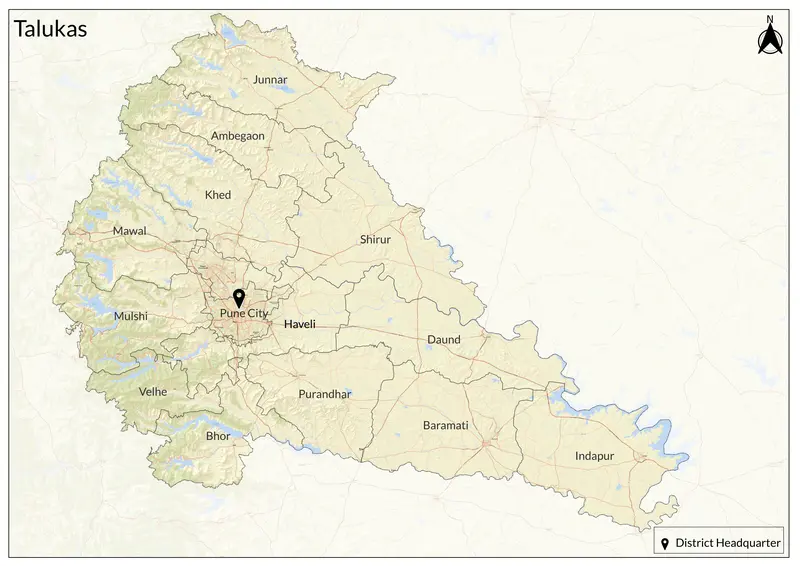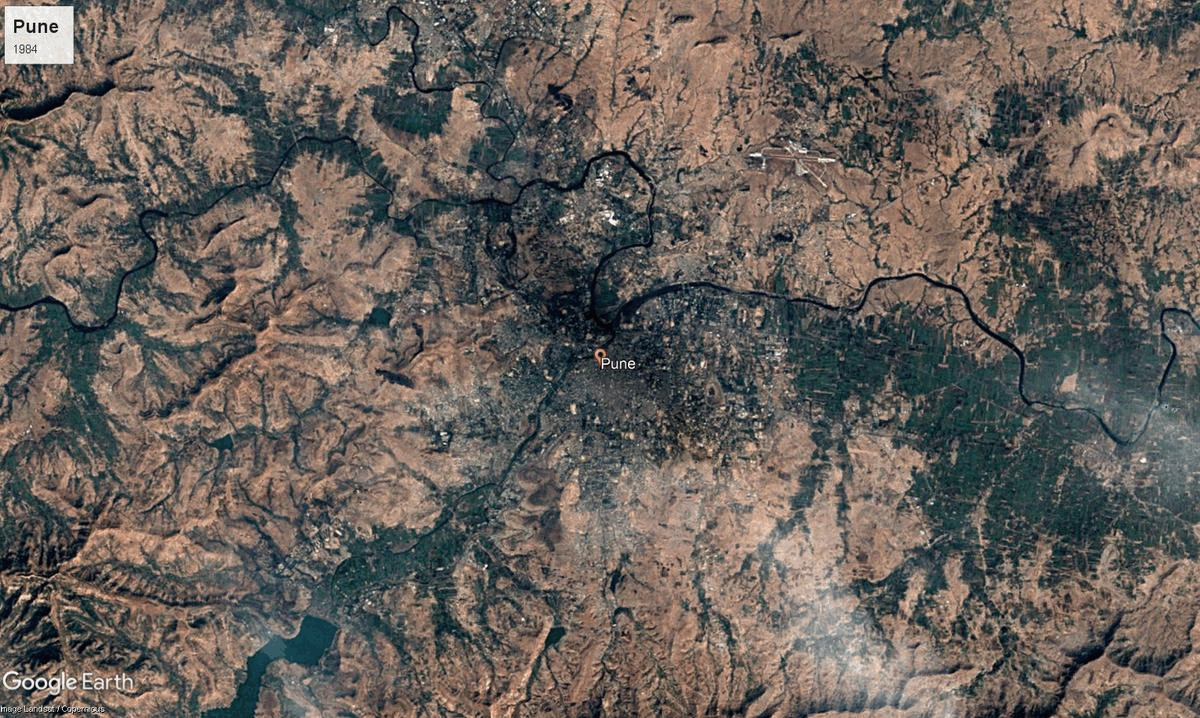Pune

15,643 sq. km
915 (2011)
~1.05 crore (2019)
~ ₹2.47 lakh crore (2019)
~ ₹2.37 lakh (2019)
Pune district, the heart of western Maharashtra, is a region where history, culture, and modernity intertwine. Pune city, its headquarters, lies on the banks of the Mula and Mutha rivers, between the Sahyadri hills and the Deccan plateau. The earliest mentions of Pune date to the 8th century as “Punna” or “Punyavishaya”, a region of sacred confluence and agricultural settlement during the Rashtrakuta era (this name appears in a Rashtrakuta copper plate from 937 AD). Over time, Pune evolved under the Satavahanas, Yadavas, and then experienced periods of prosperity and devastation as a prize in conflicts among the Nizamshahi, Adilshahi, and Mughal dynasties in the early 17th century.
Pune has been central to Maharashtra’s history for over 400 years. It was ruled by the Deccan Sultanates before becoming a stronghold of the Maratha Empire. Recovery began when Shahaji Bhosale, father of Shivaji, was granted the jagir of Pune, and his wife Jijabai and son Shivaji resided in Lal Mahal (completed 1640) at the town’s core. The rebuilding of Pune by Dadoji Konddeo after the catastrophic famine and destruction of the 1630s set the stage for the city’s golden era. Under the leadership of Balaji Vishwanath (appointed Peshwa by Chhatrapati Shahu in 1713), and his successor Bajirao I (who made Pune his seat of administration in 1720 and built the famed Shaniwar Wada), Pune became the capital of the Maratha Empire and a major power in India throughout the 18th century. British conquest in 1818 shifted Pune’s destiny again, transforming it into the “monsoon capital” of the Bombay Presidency. The British established a prominent cantonment, missionary schools, and public institutions. Pune saw the rise of educational and social reformers, Jyotirao and Savitribai Phule (the first girls’ school in India, 1848), Gopal Krishna Gokhale, and Lokmanya Tilak. By the late 19th century, railways, roads, and dams (the Khadakwasla in 1880) made Pune a thriving industrial and military hub, and the city attracted vibrant communities of Parsis, Jews, Bohras, as well as Hindu and Muslim intellectuals. After India’s independence in 1947, Pune was integrated into Bombay State, later becoming part of Maharashtra in 1960. Today, Pune district consists of 15 talukas: Pune City, Pimpri-Chinchwad, Haveli, Mulshi, Velhe, Bhor, Purandar, Baramati, Daund, Indapur, Maval, Khed, Shirur, Ambegaon, and Junnar.
Culturally, Pune district is hailed as Maharashtra’s “cultural capital.” Pune city, sometimes called the “Oxford of the East,” is legendary for its universities, historic colleges, and as a crucible of Marathi theatre, classical music, arts, and social reform. Key sites include Shaniwar Wada, the 18th-century seat of the Peshwas; Aga Khan Palace, associated with Mahatma Gandhi’s imprisonment during the freedom struggle; and the Pataleshwar Cave Mandir, dating back to the 8th century. Spiritual giants like Sant Dnyaneshwar and Sant Tukaram, as well as social pioneers like Jyotirao Phule and Savitribai Phule, worked in and around the district. Festivals such as Ganesh Chaturthi, revived by Tilak as a public celebration to foster unity, are central to Pune’s life. The district is also home to important pilgrimage centers: the Ashtavinayak Ganesh temples, Alandi and Dehu (associated with Varkari saints), Jejuri’s Khandoba temple, and numerous Jain, Sikh, and Sufi shrines. Fine cuisine, literature, museums, and a cosmopolitan student population keep Pune’s traditions vibrant and relevant. Legendary forts, Sinhagad, Rajgad, Purandar, and Shivneri, dot the district’s landscape, reminiscent of its Maratha legacy and empire-building history. The district also features Lonavala and Khandala, popular hill stations dating back to the British Raj.
Geographically, Pune lies on the western edge of the Deccan Plateau, in the leeward shadow of the Sahyadri mountain range. Pune district blends lush Sahyadri forests, high valleys, and dry plateau farming. Rivers like the Bhima, Indrayani, Pavana, and Nira cross the district, and hill stations like Lonavala, Khandala, and Panchgani overlook sweeping gorges and waterfalls. Wildlife sanctuaries (Bhimashankar, which has one of the profound Shiva Jyotirlingas) and hundreds of ancient temples contribute to a rich, biodiverse ecosystem. Pune’s rapid urban expansion has turned its former villages into bustling suburbs, blending rural and urban life.
Pune is an economic powerhouse. Its history in sugar cooperatives and cotton markets gave way to engineering, automobile manufacturing and electronics thanks to the growth of MIDC estates. In last two decades, Pune surged ahead as an IT and knowledge economy hub, with tech parks (Hinjawadi, Magarpatta), BPOs, and international firms. The city is India’s vaccine capital (Serum Institute), home to defense research, scientific innovation, and a robust real estate market. Major defense and scientific organizations, such as the National Chemical Laboratory, ARM Engineering College, the NDA, and DRDO labs, make Pune a center for innovation and research. Education, healthcare, retail, real estate, and a growing tourism sector (thanks to heritage and eco-getaways) round out Pune’s bustling economy. Agriculture persists in the hinterlands with grapes, guavas, pomegranates, rice, and other crops, supporting rural livelihoods alongside the district’s urban affluence.
